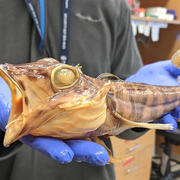
Geneticists comb DNA of ‘survivor’ fish for clues to withstanding climate change
By STEPHANIE DUTCHEN, Harvard Medical School
Some 25 to 30 million years ago, the Earth’s temperature fell. Ice caps grew and sea level dropped. Plants and animals died off as their environments rapidly shifted.
Some species, however, survived the upheaval. Among them were Antarctic fishes harboring genes that produced antifreeze proteins. The proteins prevented ice crystals from forming in cells, allowing the fish to avoid freezing solid in ocean waters that frequently dipped below 32 degrees Fahrenheit.
Today, as climate change threatens life around the world, scientists are looking to the descendants of these and other fish for genetic clues about how to withstand fluctuating temperatures and other types of environmental instability.
“Evolution has already solved these problems,” said Stephen Treaster, research fellow in genetics in the lab of Matthew Harris at Harvard Medical School and Boston Children’s Hospital.
As finalists in an HMS Department of Genetics competition that challenged trainees to use their research expertise to tackle climate change, Treaster and colleagues are sequencing the genomes of 46 kinds of fish that have adapted to extreme environments. These include modern-day Antarctic icefish, cave-dwelling sculpins, and fish that thrive in some of the deepest regions of the sea, such as eelpouts, snailfish, and blobfish.